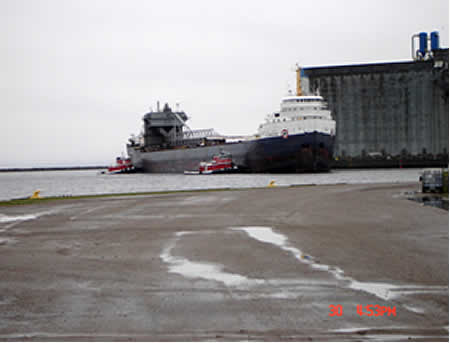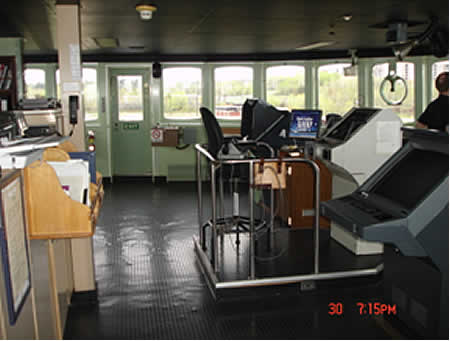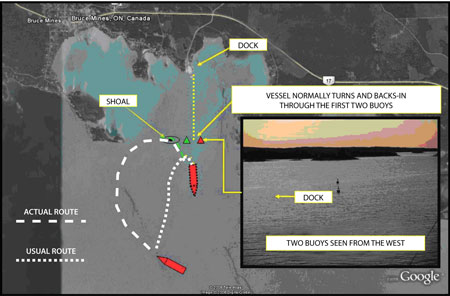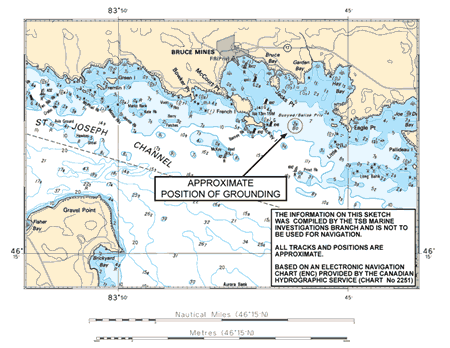Grounding
Bulk carrier Algomarine
Bruce Mines, North Channel
Lake Huron, Ontario
The Transportation Safety Board of Canada (TSB) investigated this occurrence for the purpose of advancing transportation safety. It is not the function of the Board to assign fault or determine civil or criminal liability. This report is not created for use in the context of legal, disciplinary or other proceedings. See Ownership and use of content. Masculine pronouns and position titles may be used to signify all genders to comply with the Canadian Transportation Accident Investigation and Safety Board Act (S.C. 1989, c. 3).
Summary
On the morning of 28 May 2008 at 0549 eastern daylight time, while approaching the Ontario Trap Rock loading facility near Bruce Mines, Ontario, the bulk carrier Algomarine ran aground on a charted shoal. The vessel had extensive damage but was refloated. There was no pollution.
Factual Information
Particulars of the vessel
| Name of vessel | Algomarine |
|---|---|
| Official number | 329344 |
| Port of registry | Sault Ste. Marie, Ontario |
| Flag | Canada |
| Type | Self-unloading bulk carrier |
| Gross tonnage | 18 338 |
| LengthFootnote 1 | 222.44 m |
| Draught | Forward: 4.17 m, Aft: 7.56 m |
| Built | 1968 |
| Propulsion | Sulzer (slow-speed diesel) 9 470 BHP, bow thruster |
| Cargo | Full ballast |
| Crew | 25 |
| Registered owner | Algoma Central Corporation |
| Manager | Seaway Marine Transport |
Description of the vessel
The Algomarine is a split-accommodation Great Lakes bulk carrier. The vessel's semi-circular bridge is situated atop the forward accommodation deckhouse. The bridge is equipped with two automated radar plotting aid (ARPA) radars and one electronic chart system (ECS). Two monitors for the ECS are located at the conning station - one forward and centre left, and the second further to the left and back a few metres.
The vessel is equipped with a depth sounder. The display unit was replaced on May 12, approximately two weeks prior to the occurrence.
The steering station is located on a raised platform in the middle of the bridge. This provides the wheelsman with a good view ahead while remaining within close sight of the course and rudder-angle indicators.
History of the voyage
At 1044 eastern daylight timeFootnote 2 on 27 May 2008, after discharging cargo at Serpent Harbour, Lake Huron, Ontario, the Algomarine departed in ballast for the Ontario Trap Rock loading facility near Bruce Mines, Ontario.
At 2238, the Algomarine anchored 1.6 nautical miles from the Ontario Trap Rock facility, approximately 1 nautical mile south of McKay Island in the St. Joseph Channel. Northwesterly winds were in excess of 15 knots for entering the channel to the Ontario Trap Rock facility, which exceeded the company's limit.
At 0100 on May 28, with no letup in wind speed, the master instructed the second officer (2/O) to report when winds had dropped to less than 10 knots and remained so for an hour. At 0200, the master went to sleep; he was awakened at 0445 and informed that the conditions were ideal for manoeuvring to the dock.
At 0510, the master and the first officer, who was serving as officer of the watch (OOW), were on the bridge discussing the day's activities, which included the approach and berthing at the Ontario Trap Rock facility. A few minutes later the OOW left the bridge to bring up the anchor.
At 0533, the Algomarine weighed anchor and the master ordered the vessel to proceed in a general northwesterly direction, with increased speed to nine knots, so as to navigate the vessel from a westerly position to the channel, rather than using a previously-loaded ECS route plan, which called for a commonly-used southern approach.Footnote 3
At 0544, while near abeam of McKay Island and heading in a general northerly direction, the master then initiated a conversation with the OOW, who had returned to the bridge. The conversation was unrelated to the navigational conduct of the vessel.
At 0545, the master sighted the channel entrance buoys to the east and, using them as a visual reference, ordered 35° starboard helm. Vessel speed was between 6.5 and 7 knots. At 0546, the master asked the OOW to keep the vessel turning to starboard. He then left the bridge to conduct ship's business. There was no formal handover of the con. Moments later, the wheelsman indicated that the vessel was slowing in its turn to starboard. The OOW responded by giving the engine/pitch a "kick" ahead.
At 0547, the master returned to the bridge. The OOW remained on the bridge, but there was no formal handover of the con, nor any exchange of information between the bridge team members - be it confirming the vessel's position (via the ECS, radar, or other available navigational aides) or identifying potential navigation hazards.
At 0548, the alarm went off on the vessel's depth sounder for approximately 30 seconds. The bridge team, however, was unfamiliar with the sound of the alarm and took no action before 0549, when the vessel ran aground on a charted but unmarked shoal on a heading of 090° True (T).
Immediately following the grounding, the master put the engine/pitch to full astern. He then ordered soundings of the forepeak and the port and starboard ballast tanks.
Full astern was maintained for 15 to 20 minutes without effect, after which propeller thrust was stopped. The vessel then pivoted approximately 180°, freeing itself in the process, at which point it drifted across the shoal on a heading of 283°T.
At 0736, the master put the vessel astern and backed-off the shoal into deeper water. At 0740, after clearing the shoal without further incident, the vessel proceeded to anchor in the channel.
Damage
The starboard bottom shell plating and internal structure of the vessel was extensively damaged. An inspection by a marine surveyor within days of the accident indicated that A, B, C, and D strakes from frames 32 to 87 were heavily buckled. Starboard ballast tanks Nos. 1, 2, and 3 were holed.
Weather
The winds at the time of the occurrence were 10 to 12 knots out of the northwest. By 0600 they had diminished to 8 to 10 knots.
Personnel certification and experience
The master had approximately 30 years of experience on commercial vessels plying inland waters and had held a valid Master Local Voyage certificate since 1999 issued by Transport Canada. He had commanded numerous vessels for Algoma Central Corporation since 2003 and had journeyed into the Ontario Trap Rock facility many times. This was his second trip to the Ontario Trap Rock facility in 2008 with this OOW aboard the Algomarine. He was exempt from the requirement to possess a pilot's certificate.
The OOW had approximately 25 years experience with the current company and served as first mate onboard the Algomarine since 2001. He held an Ocean Navigator I (ON I) certificate issued by Transport Canada. He was also exempt from the requirement to possess a pilot's certificate.
The master and the OOW had received both ECS and bridge resource management (BRM) training in 1997. They also received refresher training in ECS-AISFootnote 4 in 2003.
Bridge Resource Management
BRM is the effective management and utilization of all resources, human and technical, available to ensure the safe completion of a vessel's voyage.
BRM's objective is to ensure a vessel's safety, along with that of its personnel, cargo, and the environment. BRM emphasizes teamwork to optimize the use of all available resources, including equipment, written information, procedures, and personnel. All members of the bridge watch team have a role to play and, for BRM to be effective, there must be clear channels of communication and an environment conducive to open discussions, especially during critical phases of a passage.
Use of Electronic Chart System
An ECS is a system that provides mariners with real-time information for navigating vessels. When used effectively, the system can improve overall marine safety. Using an ECS in conjunction with conventional navigation methods can reduce the navigation workload. The major factor in this reduction of workload is the automation of position fixing, which allows for continuous monitoring of the vessel's progress.
Electronic charts - particularly the vector format, which was the type of chart being used aboard the Algomarine at the time of the occurrence - contain a wide range of functions for monitoring the vessel's voyage. These functions include simple visual indications and automatic monitoring alarms. On the ECS display, effective visual route monitoring can be performed and navigational alarms set up to bring the situation to the attention of the user so that he or she can intervene as required. An example is a cross-track error (XTE) alarm, which is activated when a vessel leaves the course line's set parameters.
In addition the ECS, when it uses vector data, allows for the "look ahead" function as well as the "anti-grounding" function. These functions determine if any charted danger or obstacle registered as lying ahead of the ship's current position represents a risk to the vessel.
In this occurrence, the pre-set navigation parameters had not been entered into the ECS; therefore, neither audible nor visual alarms would have sounded to indicate a risk. The shoal where the vessel ran aground was indicated on the electronic navigation chart being used at the time, and the two entrance buoys to Ontario Trap Rock had been manually added using the software's "add info." feature - albeit in a position 65 m south of their actual geographical position.
Seaway Marine Transport's (SMT's) policy on ECDIS (electronic chart display information system), which would include ECS as part of the vessel's navigation equipment, is that they should be used to their full potential. Courses, alteration points, and cross-track error (XTE) are to be pre-programmed into the system. Masters and deck officers are to observe and understand the information on the display, including its functions and limitations.
Nuisance alarms may be turned off if the vessel is secured or if it is arriving at or leaving a dock. However, prior to any decision to disable an alarm when the vessel is transiting confined waters, due consideration should be given to ensure that any electronic aid continues to be used to its maximum advantage for vessel positioning, tracking, and navigation safety.
Other navigational equipment
Depth sounder
Several days prior to the occurrence, before entering the Detroit/St. Clair River system, the master set the sounder alarm to 0.6 m.
Chart
The paper chart available on the bridge was Canadian Hydrographic Service Chart No. 2251 (Bruce Mines and Trap Rock) and is the largest scale navigation chart for the area. Its scale was 1:60 000. A more detailed electronic chart for the channel to the Ontario Trap Rock facility existed, but was not available to the bridge team at the time of the accident.
Radars
Both radars on the bridge - the port 3 cm and starboard 10 cm radar-were set at the six-mile range with one-mile range rings.
Aids to navigation
The channel to the Ontario Trap Rock facility is marked by privately-maintained buoys, some of which are lit. The port and starboard buoys marking the channel entrance are located east of the charted shoal where the vessel went aground. In addition, a set of range lights led into the berth on a bearing of 000° and two other lights - a fixed light at nearby McKay Island, along with the wharf light at Bruce Mines public wharf - would have been visible up to 15 and 8 nautical miles, respectively.
Work / rest history
The amount of rest allotted to crew members is governed by the Marine Personnel Regulations. The master of a vessel, as well as every crew member, requires at least six consecutive hours of rest in every 24-hour period and at least 16 hours of rest in every 48-hour period.Footnote 5
A master's duties, however, require that he be available at all hours, and it is not unusual for a master to be interrupted during rest periods.
In this occurrence, although the master had opportunities for rest and sleep, he obtained no more than five hours of sleep per day - and no more than 3.5 consecutive hours of sleep in any period - during the five days prior to the occurrence (see Appendix B for sleep/wake details).
Contingency plans
The Algomarine was managed by SMT. Both the managing company and the vessel were certified in accordance with the International Safety Management Code. As such, the vessel had a safety management system on board which included contingency plans in the event of grounding.
Smoking cessation with prescription drug Champix
Smoking cessation - with or without the use of prescribed drugs - can cause adverse effects due to nicotine withdrawal. Health Canada has noted that some common symptoms associated with quitting smoking are depressed mood, insomnia, irritability, frustration, and anxietyFootnote 6.
The master was a heavy smoker. In February 2008, he asked for and received from a Transport Canada designated medical examiner a prescription for the smoking-cessation drug Champix, which is known in the United States (U.S.) as Chantix.
On 01 February 2008, the U.S. Food and Drug Administration (FDA) issued an alertFootnote 7 to highlight the warnings and precautions when taking this drug, particularly regarding neuropsychiatric symptoms which may include anxiety, nervousness, tension, depressed mood, unusual behaviours, and thinking about or attempting suicide. The FDA subsequently issued a health advisoryFootnote 8 highlighting adverse effects such as disturbed sleep and an impaired ability to drive or operate heavy machinery.
At the time the prescription was issued, the doctor and the master briefly reviewed potential side effects. On 01 May 2008, the master began taking the prescribed dosage and on May 14, two weeks prior to the occurrence, he stopped smoking as prescribed. There was no requirement for the master to disclose the use of this prescription to the employer.
In June 2008, the U.S. Coast Guard issued a marine safety alertFootnote 9 notifying merchant mariners navigating in U.S. waters of the drug's potential side effects. The safety alert urges mariners to contact their physicians and recommends "immediate" cessation in the event that any of the listed side effects are experienced.
Previous occurrences involving prescription drug use
Previous TSB reports have revealed occurrences in which the performance of persons in safety-sensitive positions was adversely affected by prescription drug use. These include: M91C2004 (Griffon and Captain K), M01C0054 (Windoc), and M04L0105 (Famille Dufour II).
Analysis
Bridge Resource Management (BRM)
BRM is the effective management and utilization of all resources, human and technical, available to ensure the safe completion of the vessel's voyage. Communication is a key component of BRM. For a plan to be effective, it must be communicated to the team and understood by all members of the team. In the event of a change in plan, the modifications and their repercussions need to be discussed.
In this instance, a voyage plan had been established to the destination of the Ontario Trap Rock facility. The master deviated from the plan when he chose a westerly approach to the channel entrance. Although the OOW was aware of this deviation, the two did not collaborate on elaborating strategies to ensure the safety of this manoeuvre. During the manoeuvre, the master left the bridge momentarily and did not exchange information regarding the vessel's position with the bridge team, nor was this done upon his return. Moreover, because the master was conning the vessel visually and could see the buoys leading to the channel entrance, he did not seek confirmation of the vessel's position in relation to the shoal. The OOW also did not verify position via the ECS, radar, or other means; instead, he assumed that the vessel's manoeuvre was in accordance with the master's normal practice.Footnote 10 The master's original misperception therefore went unchecked; as a result, the bridge team remained unaware of the vessel's true position and the impending danger associated with the course alteration was not recognized until the vessel struck the shoal.
Use of Electronic Chart System
On the ECS display, effective visual route monitoring can be performed and automatic alarms set up to warn if the vessel is proceeding into danger. Using an ECS with vector data, the "look ahead" function may be used as well as the "anti-grounding" function. In this occurrence, while approaching from the west, the vector chart displayed on the ECS screen indicated that the vessel was approaching a shoal.
The benefits of the ECS, however, were not fully realized, as the bridge team did not closely monitor the progression of the vessel. In addition, appropriate alarm settings used to safely monitor the vessel's progression were not available as none of the parameters had been entered into the ECS. Events recorded by the ECS electronic logbook were automatically acknowledged by the software. However, these events were not related to alarms for pre-set navigational parameters, as they require manual acknowledgements by the users - and no such acknowledgements were recorded in the electronic log book.
Correctly entering pre-set navigation parameters for alarms such as cross-track error, look-ahead, and anti-grounding can be critical in preventing incidents. Failure to do so, combined with the lack of monitoring of the display, deprived the bridge team of a navigation system known for improving marine safety.
Use of depth sounder
Ideally, the settings on a depth sounder are increased while in deep water, so as to provide greater under-keel clearance information. It is not uncommon, however, for the settings to remain unchanged when moving from shallow to deep water. Thus, should a hazard unexpectedly come into play, warning time may be reduced and appropriate action may be delayed or precluded.
In this occurrence, the depth sounder was set at 0.6 m below the keel - a figure selected as appropriate for the vessel's earlier transit up the Detroit/St. Clair River system. The alarm setting, however, had not been subsequently changed for navigation through other areas covered during the voyage. Moreover, the bridge team was unfamiliar with the alarm, and, as a result, took no action when it sounded.
Fatigue
Quitting smoking-with or without the use of prescription drugs - has been shown to negatively impact sleep, and the master reported both disturbed sleep and difficulty getting to sleep during the five days prior to the occurrence. He managed no more than five hours of sleep per day, including a maximum of 3.5 hours of uninterrupted sleep at any one time. This was a significant sleep debt that would likely have had a negative impact on his performance. For example, he relied on visual cues instead of taking the time to make use of available bridge equipment. "Shortcutting" of tasks is a common indicator of fatigue.
In addition, the prescription drug he was taking has known side effects, including sleep disturbance. The master was not fully aware of all potential side effects for this prescription drug. Although it is difficult to establish with certainty a direct link, it is possible that the master's sleep-related symptoms (i.e., poor sleep) were more pronounced as a result of quitting smoking and the drug.
Master's response to grounding
Following any grounding, a number of steps must be taken, including: inspecting the vessel for damage, taking soundings inside and outside the vessel, looking for damage to the cargo, and looking for the release of pollutants and damage to the environment. Unless there is an immediate reason to do otherwise, it is usually prudent to remain in position.
In this occurrence, immediately after the grounding and before any other action could be taken, the master attempted to refloat the vessel by putting the engine/pitch to full astern. Only then did he order soundings of the forepeak and the port and starboard ballast tanks. Later, once the vessel was eventually free, the vessel backed into deeper water.
Such action - taken without first ascertaining the condition of the vessel - could have led to further damage to the shell plating and structural framing.
Findings
Findings as to causes and contributing factors
- Bridge resource management was not fully utilized, thereby allowing the master's original misperception of the vessel's position to go unchecked and leading to the grounding.
- Because the vessel's progress was not monitored using the electronic chart system, radar, or other means, the bridge team did not detect the impending danger.
- Lack of sleep contributed to the master's fatigue, which in turn likely affected his performance. Sleep disturbance could have been exacerbated by the negative side effects of quitting smoking and the use of a prescription drug.
- The depth sounder settings had not been adjusted and the team's unfamiliarity with its alarm decreased warning time and precluded timely action.
Findings as to risk
- The decision to refloat the vessel without first completing a damage assessment increased the risk of further damage.
Safety action
Action taken
Seaway Marine Transport
Subsequent to this occurrence, Seaway Marine Transport (SMT):
- developed and implemented an "Hours of Work Log" form for all shipboard personnel, including vessel masters and chief engineers;
- distributed to all crews and human resources personnel a copy of the United States Coast Guard Marine Safety Alert regarding Champix and its potential side effects;
- began refresher electronic chart system/bridge resource management training for all masters and permanent deck officers in the SMT fleet. This is being implemented over a five-year period ending in 2013;
- completed an internal investigation using a "root cause" analysis approach with findings, determination of causes(s), and follow-up for preventative actions;
- sent a fleet directive to all SMT-managed vessels trading into the Ontario Trap Rock facility/Bruce Mines, re-emphasizing the navigational risk associated with Bruce Mines and its approach channel and reinforcing the available mitigating actions to be taken to ensure safe navigation;
- advised vessels to review their voyage routes and add information layers on their electronic chart system for accuracy. Vessels were also advised to make full and effective use of electronic navigational equipment; and
- met with the Canadian Hydrographic Service in June 2008 regarding digitizing available field surveys into an electronic navigational chart format for the areas adjacent to the dredged Ontario Trap Rock facility/Bruce Mines channel.
This report concludes the Transportation Safety Board's investigation into this occurrence. Consequently, the Board authorized the release of this report on .
Appendix
Appendix A - Area of the occurrence
Appendix B - Master's sleep / wake history
| Day | Time | Hours of Sleep per Period | Total Hours of Sleep for the Day |
|---|---|---|---|
| 24 May 2008 | 1400 - 1600 2300 - 2400 |
2.0 1.0 |
3.0 |
| 25 May 2008 | 0000 - 0230 0530 - 0800 |
2.5 2.5 |
5.0 |
| 26 May 2008 | 0030 - 0330 | 3.0 |
3.0 |
| 27 May 2008 | 0600 - 0930 2045 - 2200 |
3.5 1.25 |
4.75 |
| 28 May 2008 | 0200 - 0445 | 2.75 | 2.75 |



